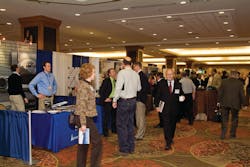Airport Planning & Design Symposium 2012
DENVER — With a final roster attendance of some 670-plus, airport and engineering professionals met here in February for the Airport Consultants Council (ACC)/American Association of Airport Executives (AAAE) annual Airport Planning, Design, and Construction Symposium.
Among session highlights, TransSolutions' Gloria Bender discussed the Level of Service (LOS) concept, and the results of the Airport Cooperative Research Program's (ACRP) Report 55: Passenger Level of Service and Spatial Planning for Airport Terminals.
The objective of the report was to identify appropriate level-of-service standards applied to each air terminal processing area; identify a holistic measure of passenger perception for the overall journey; test the validity of 30-year old space allocation parameters, and identify what parameters are most important to passengers in their perception of facility-based service quality.
According to Bender, there was no correlation between positive passenger perception and low density, or less space per passenger — and that passengers self-regulate crowding and avoid being confined. "More space per passenger does not produce higher quality scores," says Bender.
Results did show a positive correlation between short wait times at terminal processors [ticket counters, security screening checkpoint, and baggage claim] and positive passenger perception.
Says Bender, "Passengers want short wait times for passenger processors, intuitive way finding, and ubiquitous, reliable flight information." Passengers also want amenities that facilitate productive use of their time or satisfaction of their special needs, she adds.
Recommendations for airports include: Consider qualitative design factors in earliest design stages; intuitive way finding; development of ubiquitous information systems; ensure the number of passenger processors produces the shortest wait times; and plan for automation.
On the IT side of things, Air-Transport IT Services' Mark Sapp drove home his main point: "Never, ever, do an ‘IT Project’ at the airport." The first step, says Sapp, is to clearly and correctly identify the airport’s unique business challenges and opportunities — then select the right technologies to satisfy the business needs.
"Cost containment, risk mitigation, and brand delivery are key business issues for airports and airlines alike," comments Sapp. "Leveraging a shared use infrastructure environment improves terminal flexibility and enhances optimization; all stakeholders must benefit to ensure success."
Exhibitor Highlights
Lagan Construction Group — In the last ten years, Lagan has completed more than 40 airfield projects worldwide including London Heathrow, London Luton, Gatwick, Aberdeen, Belfast, Bristol, and Cardiff in the UK. In 2011, Lagan was awarded its first project on the U.S. mainland at Ronald Reagon Washington National Airport; the project was a runway overlay and safety area improvements for Runway 01-19.
Four Winds Interactive (FWi) — FWi's digtal communication platform for the aviation industry is a software solution that empowers signage administrators and passengers through an intuitive, versatile interface, says the company. Siganage administrators have the benefit of altering signs and deploying changes from a PC or web-based interface.
SIMTRA — offers its Aircraft Data Viewer, a software tool for airport operatational staff, planners, and engineers that are regularly searching for accurate and up-to-date aircraft specifications. The tool provides specs in a user friendly interface with graphics and tables that relate information such as aircraft dimensions, steering characteristics, door locations, and jet blast impacts.
G4S Technology LLC — worked on the design and replacement of the Reno-Tahoe International Airport security system. The new system includes upgraded features including access control and alarm monitoring systems, photo ID systems, closed circuit television, and the security system's LAN. The system incorporates smart card readers which will enable new clearance features such as encrypted pin codes and biometric scanning.
Beacon Products — provides the Endura Parking Structure Luminaire, a ceiling surface mounted or pendant mounted parking structure lamp with a field replaceable LED light engine and optical bezel system. According to the company, application-specific optics maximize energy efficiency by focusing illumination on key areas and preventing wasted light. ThermalFrame technology provides passive cooling in the most demanding environments.
About the Author

